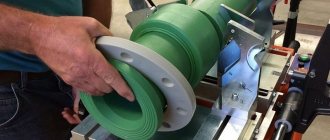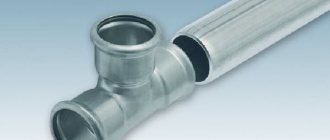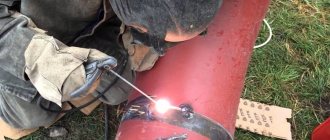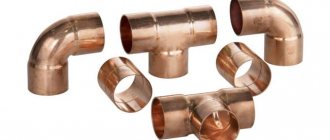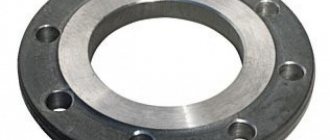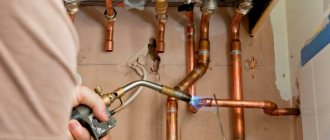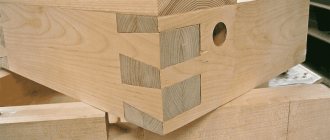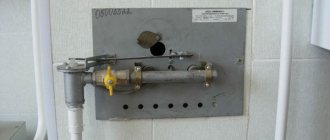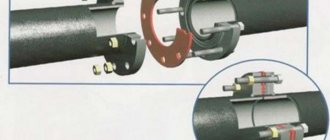Copper pipes are used much less frequently than metal-plastic or polypropylene pipes. But thanks to a set of excellent technical characteristics - thermal conductivity, anti-corrosion and biological resistance - they are found in water supply, heating, and air conditioning systems.
Long copper products are expensive, but you can save on installation. For example, soldering copper pipes with a gas torch is available to anyone who wants to independently improve the system or make repairs. We will talk about how solder joints are made and give the rules for their implementation.
Areas of use
Most often, copper pipes are used for gas transportation and as water pipes.
The production of gas equipment, brake and hydraulic systems, car air conditioners and heat exchangers cannot be imagined without copper pipe rolling. The fact that copper pipes can be reliably joined without welding makes them an attractive option for creating transport routes for viscous flammable media. However, we are not just talking about household systems. For example, fuel lines for cars are often made from copper.
Copper is very convenient for arranging water pipes, as it is not afraid of corrosion with constant contact with moisture. Such systems are characterized by a significant service life, without the need for repair measures.
It should also be noted that copper pipes are resistant to increased pressure (up to 230 atm) compared to products made of plastic or steel. Their ability to tolerate freezing well is especially valued. The products tolerate chlorine well and have antiseptic properties.
Connection methods
To connect copper pipes to each other, several methods can be used, depending on the location of the work and the requirements for the pipeline (it can be monolithic or collapsible).
Connection installation options:
- welding;
- soldering;
- fitting.
Welding of copper pipes is carried out using graphite, tungsten, copper or carbon electrodes. To organize appropriate conditions, the presence of nitrogen, argon or helium will be required. The work is carried out using a DC welding machine or a special torch. This method has one serious drawback, which is the significant difference in the characteristics of the welding joint and the pipe material. This applies to both the chemical composition and molecular structure, as well as the ability to conduct electricity and heat. This work should only be entrusted to a qualified specialist, since any mistake can lead to seam divergence.
Instead of welding, which is quite difficult to implement, under normal conditions, soldering of copper pipes is practiced. For this, a gas burner or blowtorch is used. There is low-temperature and high-temperature soldering, which differ in the type of solder and implementation mode.
Press couplings and crimp fittings are also used to create a permanent connection of copper pipes. The solder here is replaced by an adapter ring. In the first case, special pliers are used for crimping; in the second, union nuts are used (they are clamped with a wrench). When tightening the nuts, it is necessary to ensure that the ends of the copper tubes meet each other. By grinding the metal, a tight and durable connection is achieved. If you put the coupling on correctly, the connection will not leak for a long time.
Materials for sealing joints
Threaded and flange connections require additional sealing.
The choice of material for the gasket is carried out taking into account the fact that it should:
- withstand the loads specified by the design, including pressure drops;
- level out defects of the sealing surface;
- fill the space between connected elements.
That is, the gasket must be elastic, durable and dense. The most famous material that meets these requirements is linen. Flax strands are actively used to seal joints of gas and water pipes.
More modern materials - pastes, threads, sealants, FUM tape are used a little less often: due to the higher cost and some conservatism of experienced specialists.
Pros and cons of linen tape
Linen tape is tightly wound around the thread, creating a dense layer. The advantages of this method are low cost, high level of adhesion, strength of the fixed joint.
Previously, flax fibers were used with red lead impregnated with drying oil. Nowadays, special sealing pastes are increasingly being used.
Disadvantages - destruction of flax over time, difficulty in dismantling, high requirements for the experience of a specialist.
If the connection of gas pipes on a laid thread is made with too much force, the gasket may break. Such a joint will not be airtight. Therefore, it is better if the manipulation is entrusted to an experienced master.
Pastes based on oils and resins
Oil and resin compositions do not harden. The substance applied to the joint remains viscous for a long time and effectively resists the penetration of gas into the external environment.
If the gap is small, experienced specialists will choose another method, since non-hardening paste will be effective only on long threads
A big plus is the easy application, which even a novice mechanic can handle. Cons: lack of fixed fixation, low resistance to pressure.
As the pressure in the gas pipeline increases, the paste is gradually squeezed out of the connection.
Drying paste-sealants
The basis of these compositions are solvents. After application, the substance dries and provides a strong hold. Can be used alone or in combination with linen winding for gas connections.
Knowing that the threaded connection is sealed with drying sealant, it is worth checking it periodically and tightening it with a wrench. This applies to all types of pipes
Experts attribute the strength of the resulting joints to the advantages of drying sealing pastes. In addition, the composition is easy to apply: during processing it acts as a lubricant, and begins to dry out while already in the threaded gap. Disadvantages include a tendency to shrink.
Anaerobic adhesives
Viscous, non-shrinking adhesive that polymerizes without shrinkage is the best sealant for threaded and flanged gas connections. Filling the space at the joints, it solidifies only there, remaining liquid and viscous on the outside.
Excess glue can be easily removed from the surface, and the dose that gets inside will remain in the right place and quickly polymerize.
For ease of installation, manufacturers offer adhesives with different drying times. It varies from 3 minutes to several hours. This should be taken into account when choosing a composition
The only drawback of anaerobic glue is the inability to use it at low temperatures. With a strong minus, the polymerization time sharply increases. And in some situations it may not occur at all.
Nylon sealing thread
The principle of using nylon thread is similar to the method of using flax fiber: the material is wound onto the external thread of one element, and then pressed against the internal thread of another.
Benefits include:
- low cost;
- wide temperature range, the upper limit of which is fixed at 130 degrees;
- possibility of use in conditions of high humidity;
- reliability of the processed connection.
Among the disadvantages is the need to roughen the thread - it is extremely difficult to hold the material on smooth metal. In addition, nylon thread is not suitable for sealing pipe joints with a diameter of more than 80 mm.
PTFE tape
FUM tape is a relatively new type of sealant, but quite popular. Its main advantages are elasticity, chemical resistance and heat resistance.
The tape is easy to wind, has a long service life, and is suitable for metal and polyethylene pipes.
It is important to apply FUM tape correctly: on a previously degreased surface, observing the direction of the thread. If the test shows a gas leak through the treated connection, then to correct it it is necessary to completely remove the old winding
However, there are also disadvantages. This is a low level of sealing of connections of large diameters and sensitivity to irregularities - roughness, nicks, and metal shavings can easily disrupt the integrity of the tape.
More about capillary soldering
Most often, in domestic conditions, copper pipelines are organized using capillary soldering. The essence of this method is the so-called capillary effect, which provides for the possibility of raising liquid (liquid solder) using adhesion. The main condition is that the wetted walls are separated by a short distance.
The organization of a connecting point for copper pipes in domestic conditions is carried out using special fittings for soldering or bell-shaped thickenings. The socket method is considered more reliable, since in this case we are talking about creating only one joint. Based on this, if possible, it is recommended to use socket connections instead of fittings.
The procedure for preparing sockets
Pipe cutting to size is carried out using a rolling pipe cutter. It is important to achieve strict perpendicularity of the end cuts relative to the central axis.
Next, chamfer both ends. To do this, you will need a special device - a chamfer remover. Further cleaning of the internal and external surfaces of the connected pipes is carried out with a copper brush.
Having inserted one of the pipe sections into a vice, it is flared in order to achieve free immersion of the second section into it. For this purpose, a special pipe expander of the appropriate diameter is used.
The result of flaring is the arrangement of a socket at one end of the copper pipe. Testing the level of its readiness during the procedure is carried out by periodically immersing the other, smooth end.
Soldering machine application
In addition to the already mentioned pipe cutter, chamfer and pipe expander, some other tools will be required to solder copper pipes.
First of all, we are talking about a soldering iron. Thanks to this device, a high-temperature zone is created in the joined area for heating the pipes and solder. As a rule, the function of a soldering iron is performed by a special gas burner.
For procedures where soft solder is used, a compact hand-held device powered by propane is quite suitable. As a rule, such devices are equipped with disposable gas cylinders attached to the handle. Despite their small dimensions, burners of this type are capable of providing heating up to +1100 degrees: this is quite enough for working with soft solder. When purchasing, it is recommended to choose models with piezo ignition, which significantly simplifies soldering.
Manual gas burner holders are equipped with an adjustment valve that allows you to adjust the flame length. The same valve allows you to stop the gas supply at the end of work. The purpose of the check valve is to shut off the fuel supply if the flame goes out.
Other required materials
Solder is sold in rods or wire with a lower melting point compared to copper.
This makes it possible to connect copper pipes using the melting method. For soldering you will need a steel bristle brush. With its help, pipes and fittings are cleaned for subsequent connection. The brush can be replaced with fine-grained sandpaper.
You cannot do without soldering flux and a brush (to apply the flux). You will also need a fireproof gasket, a hammer, a vice, and a tape measure.
How to solder the heat exchanger of a gas water heater if the fistula is in a place inaccessible for soldering
If the location of the water leak occurs on the wall of the heat exchanger adjacent to the base of the gas water heater, then repairing the heat exchanger by soldering on site is impossible, and it must be removed from the gas water heater. The designers of NEVA LUX-5013 did their best. To remove the heat exchanger for repairs, you need to disassemble almost the entire gas water heater and, most unpleasantly, disconnect the gas pipe. I didn’t want to mess with gas pipes, as it’s dangerous.
The removal of the heat exchanger for repair was hampered by an umbrella for removing gas combustion products, secured with four aluminum rivets to the base of the gas water heater. I had to drill out these rivets with an electric drill, remove the umbrella, and only then did it become possible to remove the heat exchanger. During assembly, instead of rivets, the umbrella was secured to the base with two M4 screws. If the wall does not interfere, you can secure the umbrella with self-tapping screws.
Next, the repair of the gas water heater was carried out using the technology described above. Over the past two years, I have had to repair the heat exchanger, soldering the fistulas, five times. The last time, water began to leak from the side adjacent to the wall of the heat exchanger, and I decided to buy a new one, which I did. I'm going to repair the old heat exchanger of the geyser, I'll tin and solder the tube along its entire length. Photo of the heat exchanger from the side attached to the base.
When purchasing a heat exchanger for a geyser, I was surprised to find that they gave me not a new one, but an already repaired one. The heat exchanger tube had the same soldering that I did when repairing my old heat exchanger. As a result, out of four available in the store, only one heat exchanger was not soldered. It turns out that the plant ships repaired heat exchangers for spare parts that failed during the warranty period. They seal fistulas in them and sell them again. The heat exchanger has a warranty period of only 1 month. It turns out that in a few months the gas water heater will have to be repaired again!
If you have to buy a heat exchanger for a geyser, carefully inspect it. If soldering is detected, it is better to refuse the purchase. If you replace a heat exchanger in a gas water heater under warranty, make sure that you are not getting a refurbished heat exchanger that was in use, but a new one.
Fluxes and solders
Good switching quality can be achieved with both soft and hard solders for copper pipes.
When using low-temperature materials, the strength of the connecting seams is somewhat reduced, but the temperature regime used does not violate the integrity of the copper. Typically, these solders are 95% tin. Substances containing a certain proportion of silver are especially in demand.
High-temperature soldering is carried out using solid copper-phosphorus solder (the proportion of phosphorus is approximately 6%), sold in the form of rods.
Flux refers to a special composition in the form of a liquid or paste, due to which the molten material flows into the joint. This is achieved by improving the adhesion of the solder to the pipe and creating protection for the connecting seam from the penetration of air bubbles into it. In this case, the use of any flux for copper is permitted. They are usually made from zinc chloride or borax.
Features of working with soft solder
Using the low-temperature method, they install water pipes and heating systems, as well as solder pipes for air conditioners and refrigerators, the ambient temperature of which does not exceed +130 degrees. In this way, you can connect pipes with a cross-section of no more than 10 cm. As work progresses, copper products are rolled, cleaned, treated with flux and inserted into each other. The connecting section must be heated to +200-250 degrees, followed by applying solder to the joining edges.
When using a burner, it is important not to overdo it, as its temperature sometimes rises to +1000 degrees. Therefore, it is recommended to heat the bonded surfaces in series of 15-20 seconds, constantly moving the flame. The guideline for the heating level is usually the color of the flux (it should darken). Next, soft solder is introduced into the working area: upon contact with the copper base, tin melts and flows along the flux into the seam. It is necessary to ensure that the space from the socket to the pipe is completely filled with heated material.
Tool selection
If we are talking about products of significant size, let’s put the electric soldering iron, the temperature of which reaches a maximum of 500 degrees Celsius, aside and proceed to choosing a gas burner, since blowtorches are less convenient for work. The following criteria should be taken into account:
- Flame temperature. If for a home workshop you can limit yourself to purchasing a device in which this parameter reaches 1000 - 1500 degrees, then a professional needs the temperature to reach 2000 degrees. This will allow you to work with large parts and use refractory solders and fluxes.
- Flame shape and size. For point work, it is important that it has a pencil shape and is as compact as possible. But for soldering large volumes of copper, a wide swirl flame is used. It is convenient when a gas burner has several replaceable nozzles and an adjustment system that allows for precise adjustments.
- Convenience. Devices mounted on portable gas cylinders are also suitable for home use. But in production it is better to use burners connected to large gas cylinders using a hose. They are more convenient to use and designed for long-term use.
The burner must be supplied with a bracket for securing replacement blades and a set of blades of various sizes and cross-sections. Some people try to make a burner with their own hands. But this requires special knowledge and accurate calculations. It is much easier to buy a ready-made tool.
Working with hard solder
It is recommended to solder copper communications with hard solder in cases where they are planned to be used for operation at temperatures exceeding +110 degrees. In this case, the gas-flame method is suitable for creating temperatures above +700 degrees. In this case, it is necessary to anneal the copper to soften it.
Thanks to the use of copper-phosphorus solder, flux can be omitted: the main thing is to achieve uniform heating of the switched edges. As for the stages of work, they are the same as when working with soft solder.
What to pay attention to
When soldering copper pipes with your own hands, you should remember the typical mistakes made by novice craftsmen:
- weak heating of the pipe or solder. The result of this will be a lack of softening of the solder wire, causing it to stick to the flux only in fragments. The very first switching on of the pipeline may cause the seam to spread;
- insufficient flux application. You need to spread the paste very carefully, without leaving any gaps. Otherwise, the solder will either not stick at all, or will fall off after hardening;
- pipe overheating. This leads to flux burnout.
When soldering at home, you must carefully follow safety rules, since we are talking about the use of open flames and chemicals. You need to work in glasses, gloves and an apron. It is advisable that the workplace be equipped with a good exhaust hood.
Safety precautions when soldering copper pipes
One should never ignore safety precautions when a person is interested in how professionals solder copper products. First of all, you need to remember that any copper structure becomes very hot when exposed to a burner flame. Therefore, under no circumstances should you take the part with unprotected hands. You can use pliers to move short elements. It is recommended to wear mittens.
It is necessary to prevent flux from coming into contact with the skin. If such a situation does arise, then the aggressive composition is washed off with soapy water.
Work must be performed in thick clothing. It is recommended to wear cotton items. Clothes made from synthetic fabrics cannot be used during soldering, because artificial fibers easily melt.
The process of joining parts must be performed with good ventilation, since the flux often catches fire during soldering. Therefore, dangerous vapors appear in the air.
After completing installation work, the system must be washed with water. It should be hot and clean. This allows you to get rid of excess consumables inside the pipeline.
